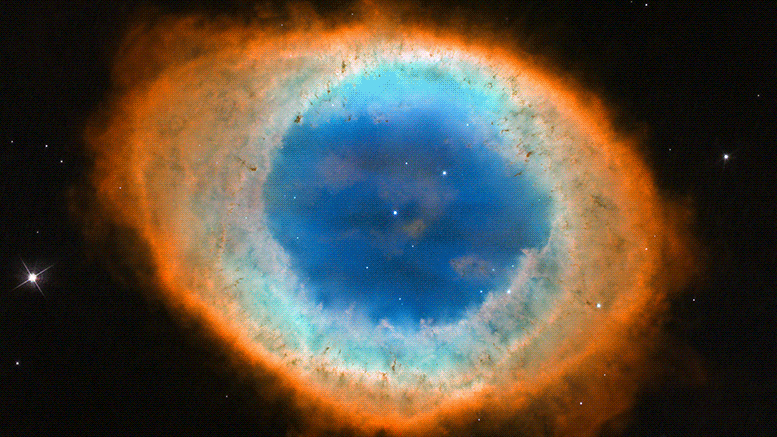
Skywatchers i juni vil ønske å se planetene Saturn, Mars, Jupiter og Venus, Hercules-klyngen og stjernebildet Lyra.
Hva skjer i juni? Et planetarisk oppbrudd, førsteklasses visning for en velkjent stjernehop, og stjernebildet Lyra.
Høydepunkter for skywatching for juni 2022 inkluderer samlingen av fire planeter med blotte øyne ([{” attribute=””>Saturn,
Samlingen av fire planeter med blotte øyne vi har hatt på morgenhimmelen de siste månedene – inkludert flere nære konjunksjoner, begynner å bryte opp. I løpet av de neste månedene vil Saturn, Mars, Jupiter og Venus vises i økende grad spredt over morgenhimmelen – så mye at Venus og Saturn vil gjøre sine utganger som morgenobjekter for de fleste observatører innen september.
Se etter denne stadig mer spredte planetpresesjonen i juni, og legg merke til at halvmånen hopper inn i oppstillingen om morgenen den 23.

Planeter fortsetter å lage et show om morgenen før soloppgang i juni, og månen slutter seg til lineupen den 23. Kreditt: NASA/JPL-Caltech
Juni er en utmerket tid for å observere en av de mest kjente kuleformede stjernehoper – M13, også kjent som Hercules Cluster. Kulehoper er sfæriske samlinger av stjerner, tett pakket sammen i midten. Selve M13 inneholder flere hundre tusen stjerner.
Kulehoper er også ekstremt gamle. Stjernene i M13 antas å være rundt 12 milliarder år gamle, som nærmer seg selve universets alder. Hjemmegalaksen vår, den[{” attribute=””>Milky Way, is known to have about 150 globular clusters. They orbit outside the galaxy’s disk, traveling tens of thousands of light-years above and below its spiral arms and most of its stars.

Find M13 in Hercules by first locating the stars that form the Keystone, about a third of the way between bright stars Vega and Arcturus. Credit: NASA/JPL-Caltech
Now, the Hercules Cluster is best observed with a telescope, and larger telescopes will allow you to see more of the cluster’s stars. But you can also find it with a pair of binoculars, where it’ll look like a hazy little spot.
Find M13 in the constellation Hercules, which is high in the east in the first couple of hours after dark in June.

This image, taken by the Advanced Camera for Surveys on the Hubble Space Telescope, shows the core of the great globular cluster Messier 13 and provides an extraordinarily clear view of the hundreds of thousands of stars in the cluster, one of the brightest and best known in the sky. Just 25,000 light-years away and about 145 light-years in diameter, Messier 13 has drawn the eye since its discovery by Edmund Halley, the noted British astronomer, in 1714. The cluster lies in the constellation of Hercules and is so bright that under the right conditions it is even visible to the unaided eye. Credit: ESA/Hubble and NASA
First look for the bright stars Vega and Arcturus.
Then find the four stars that comprise “the Keystone,” which is the pattern making up the central part of Hercules.
You’ll find M13 about a third of the way between the two stars on the western, or leading, side of the Keystone.
So check out the Great Globular Cluster in Hercules, M13, in June, and find yourself staring at an ancient gathering of stars that soars high above the Milky Way.

Lyra is easy to locate in the sky, thanks to the brightness of Vega, which is part of the Summer Triangle asterism. Credit: NASA/JPL-Caltech
Finally in June, a quick introduction to one of the smaller constellations that’s home to one of the brightest stars.
That’s the constellation Lyra.
It represents a lyre, or harp, played by the musician Orpheus in Greek mythology.
In Arab cultures, as well as ancient Egypt and India, Lyra was seen as an eagle.
And the Inca of South America saw it as a llama.
Find Lyra by looking for Vega, which is the westernmost of the three bright stars in the Summer Triangle.

This image shows the dramatic shape and color of the Ring Nebula, otherwise known as Messier 57. From Earth’s perspective, the nebula looks like a simple elliptical shape with a shaggy boundary. However, observations combining existing ground-based data with new NASA/ESA Hubble Space Telescope data show that the nebula is shaped like a distorted doughnut. This doughnut has a rugby-ball-shaped region of lower-density material slotted into its central “gap,” stretching towards and away from us. It is located about 2,500 light years from Earth in the Lyra Constellation. Credit: NASA, ESA, and C. Robert O’Dell (Vanderbilt University)
In the Northern Hemisphere, you’ll find it halfway up the eastern sky in the first couple of hours after dark in June.
Vega is by far the brightest star in Lyra.
It’s the fifth brightest star in the sky and the second brightest in the Northern Hemisphere, after Sirius.
A pair of binoculars will help you see the others stars in Lyra, which form a sort of parallelogram hanging beneath it.
It’s sometimes described as looking a bit like a diamond ring, with Vega as the diamond.
And that’s not the only ring in Lyra. It’s also home to the famous Ring Nebula, where a star has blown off most of its outer layers, leaving behind a remnant star known as a